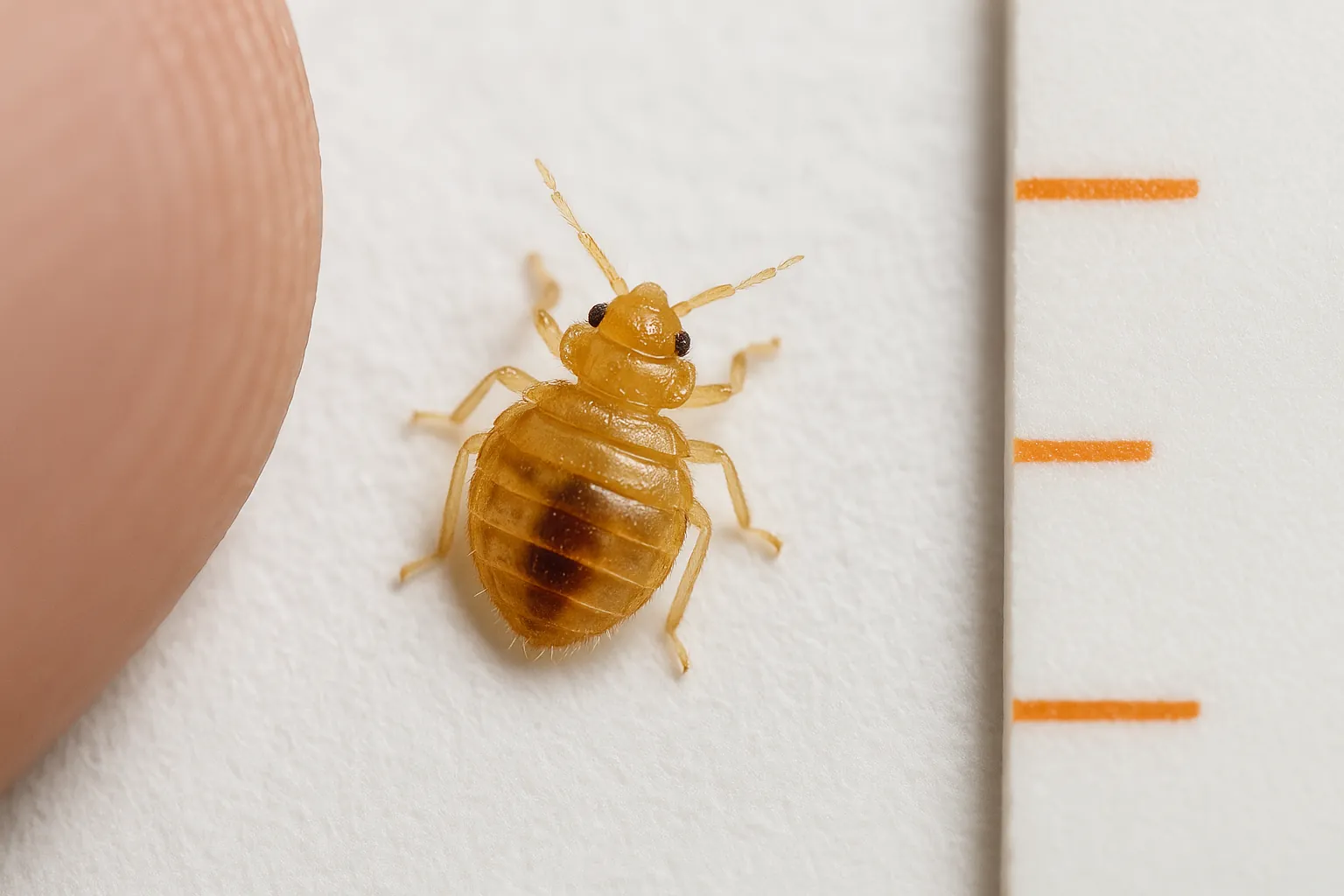
Is That a Baby Bed Bug? Get Instant AI Photo ID Free
Get Instant Bug ID
Upload your photo and get expert analysis in your email within minutes.
Not Sure If It's a Baby Bed Bug?
Don't guess—get AI-powered identification before baby bugs multiply into expensive problems.
Spotted a tiny, brownish bug crawling near your bed and wondering if it's a baby bed bug? You're smart to investigate early—baby bed bugs are only 1-2mm long but multiply rapidly into expensive infestations that can cost thousands to eliminate professionally. Understanding these precise measurements allows you to assess infestation severity and catch breeding populations before they explode.
The good news? Modern AI technology now makes expert-level identification available instantly, 24/7. Our advanced image recognition system can analyze your photo and deliver professional-grade results to your email within moments—no appointment scheduling, no costly inspection fees, no strangers in your bedroom.
This comprehensive guide shows you exactly what baby bed bugs look like at every growth stage, plus how our AI-powered tool can confirm your suspicions and generate a complete, personalized treatment plan that costs a fraction of professional extermination. Ready for instant analysis? Upload your photo here: 👉 AI Recognition Tool
By the end of this guide, you’ll confidently identify baby bed bugs and have access to the same treatment methods professionals use—but at a fraction of the cost and with complete privacy.
Table of Contents
- What Baby Bed Bugs Actually Look Like
- Baby Bed Bug Size Guide
- The 5 Nymph Development Stages
- Where Baby Bed Bugs Hide
- Baby Bed Bugs vs. Look-Alikes
- Life Cycle & Growth Timeline
- Detection & Inspection Guide
- Smart Treatment Options
- Why AI Recognition Beats Guesswork
- Early-Stage Evidence Recognition
- Age-Specific Treatment Considerations
- Frequently Asked Questions
What Baby Bed Bugs Actually Look Like
Baby bed bugs, scientifically called nymphs, are the immature stages of bed bugs that pose the greatest identification challenge. Unlike their brown adult counterparts, baby bed bugs start nearly transparent and gradually develop color through five distinct growth phases. Their translucent color and tiny size make baby bed bugs especially difficult to detect—especially in the early instars.To see high-resolution images of their appearance, check our dedicated photo guide: What Do Baby Bed Bugs Look Like?. For comparison with adult forms, see what bed bugs look like to the human eye.
Key Visual Characteristics:
- Starting appearance: Almost completely translucent or pale yellow
- Post-feeding color: Light reddish-brown after blood meals
- Body shape: Flat, oval-shaped like miniature apple seeds
- Movement pattern: Quick, scurrying motion when disturbed
- Texture: Smooth exoskeleton that becomes more defined with age

The biggest challenge with baby bed bugs is their size-to-visibility ratio. At 1mm, they’re technically visible to the naked eye but easily mistaken for debris, lint, or other household particles. This is precisely why our AI-powered recognition system excels—it can instantly distinguish between baby bed bugs and harmless look-alikes that fool even experienced homeowners.
Skip the guesswork entirely. Traditional identification methods are unreliable and waste precious time while bed bugs multiply. Our AI-powered recognition system provides the same accuracy as a professional entomologist—instantly, privately, and at no cost. Simply upload your photo and get expert-level analysis delivered to your email: 👉 https://bedbugtreatmentkit.com/get-started/
Baby Bed Bug Size Guide
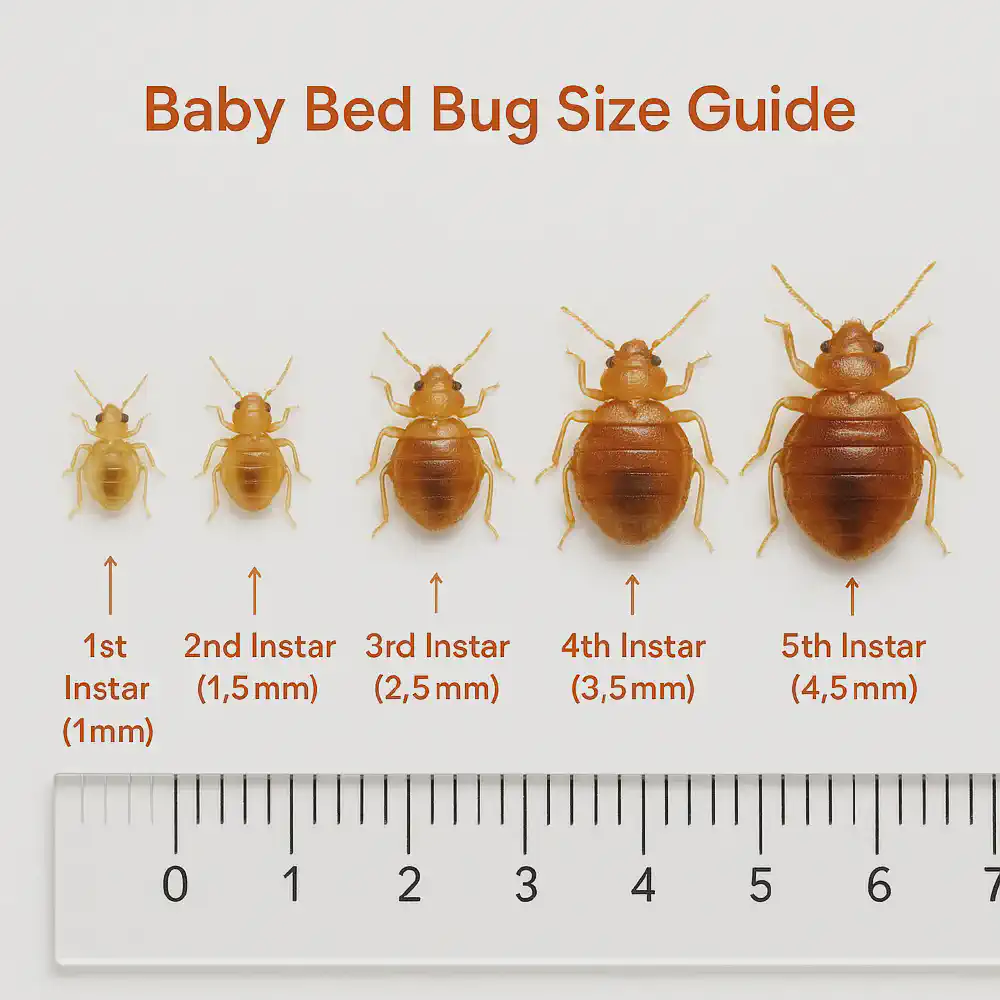
Understanding baby bed bug sizes at each developmental stage is crucial for accurate identification. Here’s the complete size progression that signals active breeding in your home. Need a visual size reference? View actual photos with millimeter comparisons in our guide: Baby Bed Bug Size by Instar Stage
| Nymph Stage | Length (mm) | Visual Comparison | Key Identifying Features |
|---|---|---|---|
| 1st Instar | 1.0-1.5mm | Grain of salt | Nearly transparent, barely visible |
| 2nd Instar | 1.5-2.0mm | Sesame seed | Light yellow, more defined shape |
| 3rd Instar | 2.0-2.5mm | Apple seed tip | Visible segments, brownish tint |
| 4th Instar | 2.5-3.5mm | Rice grain width | Clear oval shape, darker coloring |
| 5th Instar | 3.5-4.5mm | Small ladybug | Distinct features, reddish-brown |
Can You See Baby Bed Bugs With the Naked Eye?
Yes, but detection difficulty varies dramatically by stage:
- Stages 1-2: Extremely challenging without magnification
- Stages 3-4: Visible with good lighting and careful inspection
- Stage 5: Clearly visible, resembles miniature adult bed bugs
Magnification Requirements:
- Smartphone camera: Adequate for stages 3-5 with macro mode
- Magnifying glass (5x): Helpful for stages 1-2 identification
- Professional inspection: Often misses early stages without proper equipment
This size progression explains why finding baby bed bugs indicates an established infestation—by the time they’re easily visible, reproduction has been occurring for weeks.
Size Matters for Treatment
Upload your bug photo—we'll identify the exact stage and send detailed results.
Found Something This Small?
Different stages need different treatments—get it right the first time.
The 5 Nymph Development Stages
Baby bed bugs progress through five distinct molting stages, each requiring a blood meal to advance. Understanding these stages helps determine infestation age and treatment urgency.
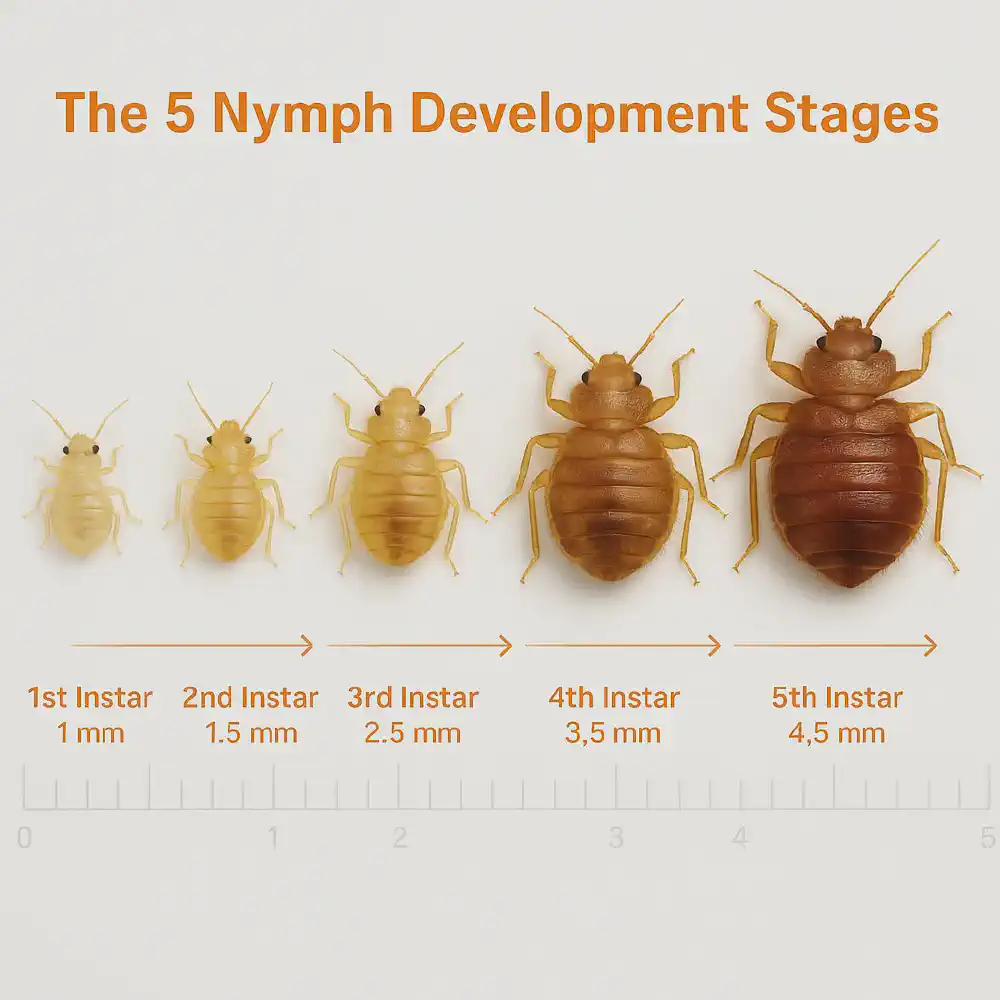
First Instar (Newly Hatched)
- Size: 1.0-1.5mm
- Color: Nearly transparent with slight yellowish tint
- Behavior: Extremely vulnerable, must feed within 48-72 hours
- Evidence: Often found near egg clusters
Second Instar (1-2 Weeks Old)
- Size: 1.5-2.0mm
- Color: Light yellow to pale brown
- Behavior: More active, seeks hiding spots during day
- Evidence: First visible shed skins appear
Third Instar (2-3 Weeks Old)
- Size: 2.0-2.5mm
- Color: Light brown with visible body segments
- Behavior: Established feeding pattern, more confident movement
- Evidence: Increased fecal spotting in hiding areas
Fourth Instar (3-4 Weeks Old)
- Size: 2.5-3.5mm
- Color: Medium brown, approaching adult coloration
- Behavior: Nearly adult-like behavior patterns
- Evidence: Larger shed skins, more obvious bite patterns
Fifth Instar (4-6 Weeks Old)
- Size: 3.5-4.5mm
- Color: Dark brown to reddish-brown after feeding
- Behavior: Preparing for final molt to adulthood
- Evidence: Adult-sized evidence, reproductive potential developing
Critical Timeline Insight: Finding multiple nymph stages simultaneously indicates ongoing reproduction and requires immediate comprehensive treatment. Our AI system can identify specific stages and recommend stage-appropriate treatment intensity.
Where Baby Bed Bugs Hide
Baby bed bugs exhibit different hiding behaviors than adults, making targeted inspection crucial for early detection. Their smaller size allows access to hiding spots adults cannot reach, which makes them key indicators of early signs of a bed bug infestation.
Primary Baby Bed Bug Hiding Locations:
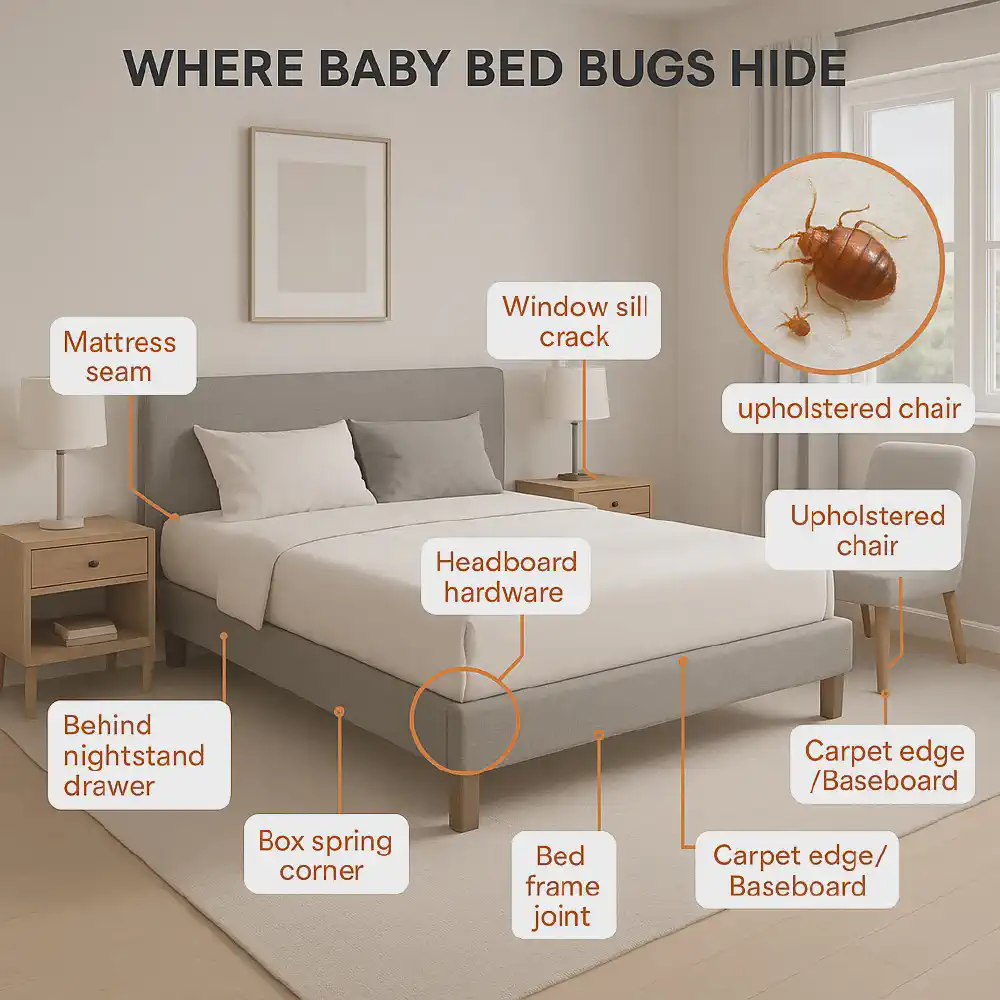
Bedroom-Specific Areas
- Mattress seams: Especially head and foot end crevices
- Box spring corners: Fabric tears and staple areas
- Bed frame joints: Screw holes and corner connections
- Headboard attachments: Wall-mounting hardware gaps
- Nightstand drawers: Behind drawer slides and joints
Beyond the Bed Zone
- Electrical outlets: Within 8 feet of sleeping areas
- Picture frames: Behind frames near beds
- Window sill cracks: Natural entry points from outside
- Carpet edges: Along tack strips and baseboards
- Upholstered furniture: Seams of chairs and sofas
Baby-Specific Behavior Patterns
- Proximity preference: Stay within 8 feet of feeding source
- Tighter spaces: Can squeeze into cracks as thin as credit cards
- Vertical movement: Climb walls more readily than adults
- Group clustering: Often found in small colonies near egg sites
Discovery Timeline by Location:
- Week 1-2: Mattress seams and nearby crevices
- Week 3-4: Expanded to bed frame and furniture
- Week 5+: Room-wide distribution, multiple harborage sites
Understanding these patterns helps focus inspection efforts and explains why early detection through AI analysis is so valuable—catch them before they establish multiple hiding locations throughout your bedroom.
Found One in These Spots?
Location matters—upload your photo and we'll assess what you found.
Worried About What You Missed?
Baby bed bugs hide deep—catch them before they spread room-wide.
Baby Bed Bugs vs. Look-Alikes
Baby bed bugs are frequently confused with other small insects, leading to delayed treatment or unnecessary panic. Some people also confuse bed bugs with ants due to their movement and body segmentation. If you’re unsure, explore this side-by-side comparison: do bed bugs look like ants?. Here’s the definitive comparison guide for accurate identification.
| Characteristic | Baby Bed Bugs | Carpet Beetle Larvae | Spider Beetles | Booklice |
| Size Range | 1-4.5mm | 2-5mm | 1.5-3.5mm | 1-2mm |
| Body Shape | Flat, oval | Fuzzy, elongated | Round, globular | Soft, wingless |
| Color | Translucent to brown | Brown with hair tufts | Reddish-brown | Pale yellow/white |
| Movement | Quick, purposeful | Slow, rolling motion | Erratic, jumpy | Very fast |
| Location Found | Near beds, feeding sources | Carpets, natural fibers | Food storage areas | Books, papers, humidity |
| Feeding Signs | Blood spots, bite marks | Fabric damage | Food contamination | Paper/mold damage |
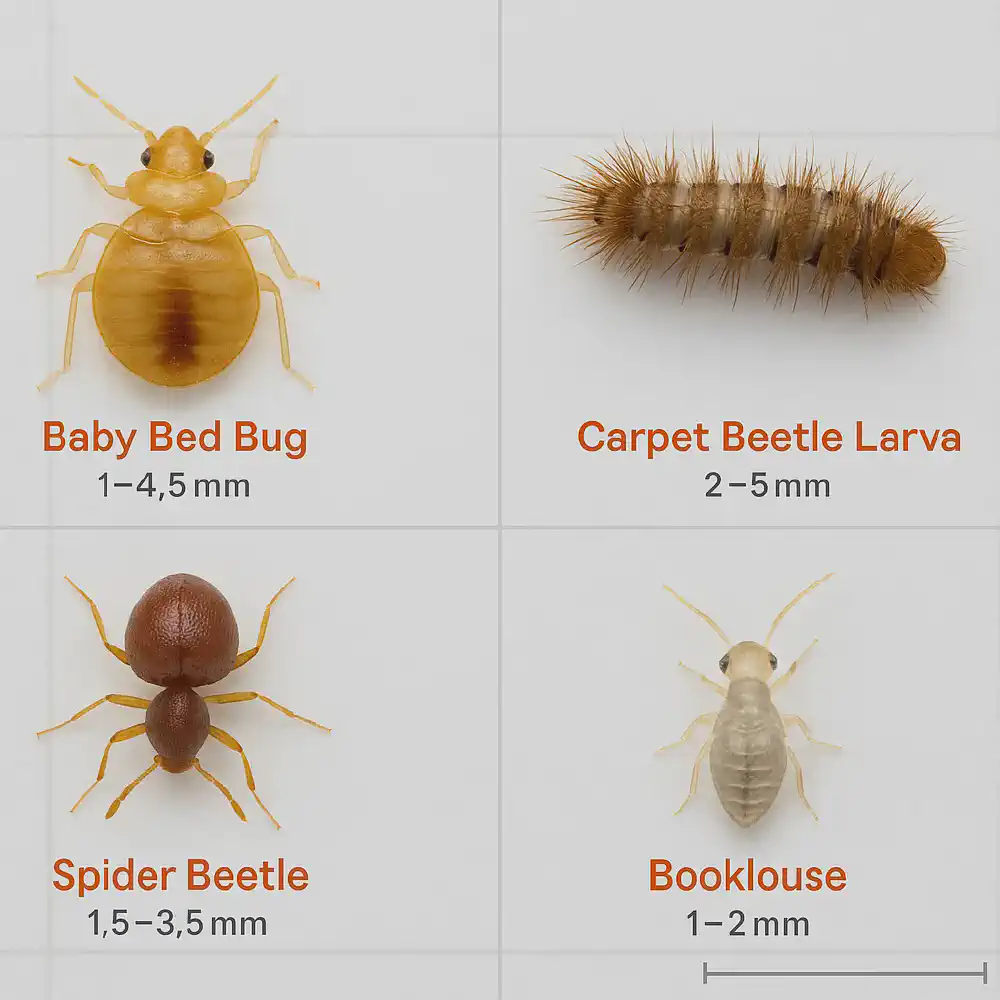
Key Distinguishing Features:
Baby Bed Bugs:
- Flat body allows hiding in thin cracks
- Found exclusively near sleeping areas
- Leave blood evidence after feeding
- Systematic, organized movement patterns
Carpet Beetle Larvae:
- Fuzzy, hairy appearance
- Feed on natural fibers, not blood
- Found throughout house, not concentrated near beds
- Leave shed hair tufts as evidence
Spider Beetles:
- Rounded, almost spherical body
- Often found in food storage areas
- More active during daylight hours
- Feed on stored food products
Booklice:
- Extremely small and fast-moving
- Require high humidity environments
- Feed on mold, paper, and organic matter
- Found in bathrooms, basements, books
Concerned this might be a baby bed bug? Here’s the smart, modern approach: Our AI analyzes your photo with professional-grade accuracy, then generates a personalized treatment plan that saves you hundreds compared to exterminators. No appointment delays, no invasive inspections, no overpriced treatments—just intelligent, automated solutions: Upload Photo for AI Analysis
Stop Second-Guessing
Upload your photo—AI distinguishes bed bugs from harmless lookalikes instantly.
Still Not 100% Sure?
Misidentification wastes time while real bed bugs multiply—get certainty now.
Life Cycle & Growth Timeline
Understanding this timeline helps in detecting an infestation before it spreads to other rooms in your home. The timeline from egg to reproductive adult reveals why early detection is critical. Bed bugs require blood to molt through each stage, but they can survive surprisingly long between meals. Learn how long bed bugs can live without feeding and why even temporary vacancy doesn’t guarantee elimination.

Complete Development Timeline:
Egg Stage (Days 1-10)
- Duration: 6-10 days depending on temperature
- Appearance: 1mm, pearl-white, sticky surface
- Location: Clustered in protected crevices
- Vulnerability: Resistant to most treatments except heat
Nymph Development (Days 10-50)
- Total Duration: 35-48 days through 5 stages
- Blood Meal Requirement: Must feed between each molt
- Growth Rate: Doubles in size with each stage
- Temperature Dependency: Faster development in warm conditions
Adult Stage (Day 50+)
- Reproductive Capability: Begins within 2-3 weeks
- Egg Production: 1-3 eggs daily for 300+ days
- Lifespan: 6-12 months under ideal conditions
- Population Impact: Single female produces 200-500 eggs
Population Growth Mathematics:
Starting with just 10 baby bed bugs:
- Week 6: 50-100 individuals (first generation matures)
- Week 12: 200-500 individuals (reproductive multiplication)
- Week 18: 1,000-2,500 individuals (exponential growth)
- Week 24: 5,000+ individuals (full infestation)
This exponential growth pattern explains why professional exterminators charge $1,500-3,000+ for established infestations—the problem becomes exponentially more complex with time.
Feeding Frequency by Life Stage:
- 1st-2nd Instar: Every 3-4 days
- 3rd-4th Instar: Every 5-7 days
- 5th Instar: Every 7-10 days
- Adults: Every 5-10 days
Temperature Impact on Development:
- 68-72°F: Normal development timeline (35-48 days)
- 75-80°F: Accelerated development (25-35 days)
- Below 65°F: Delayed development (50+ days)
- Above 85°F: Stress response, potential mortality
This timeline emphasizes why our AI-powered early detection system is so valuable—catching baby bed bugs in their first 2-3 weeks prevents the exponential multiplication that makes professional treatment necessary.
Detection & Inspection Guide
Systematic inspection techniques specifically designed for baby bed bug detection can reveal infestations weeks before they become visible to casual observation.If you suspect the presence of more than just nymphs, here’s how to identify a full bed bug infestation using visual cues, bite patterns, and inspection techniques.
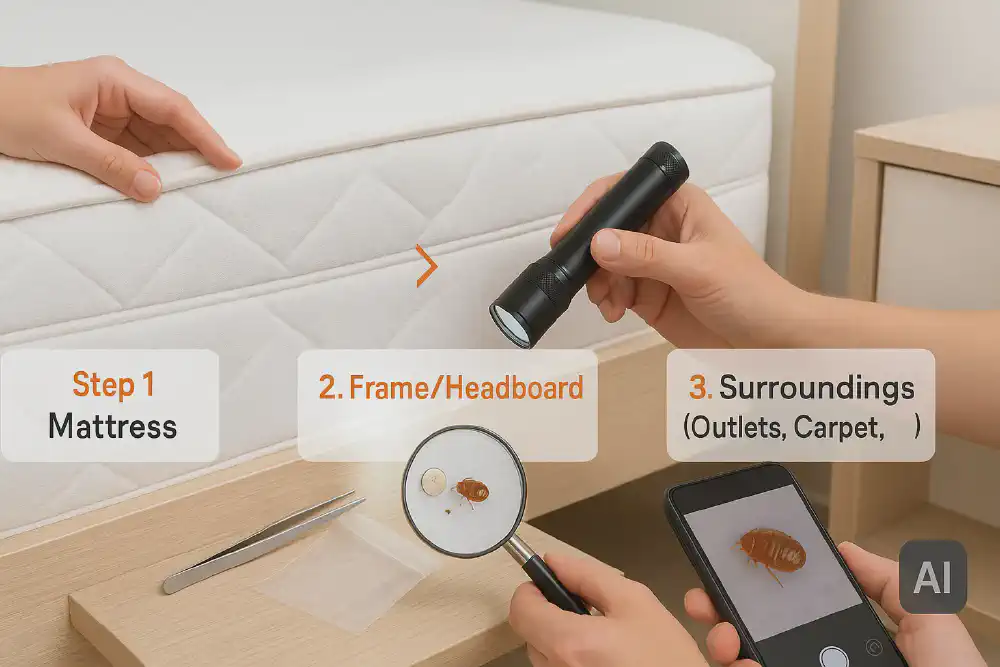
Essential Detection Equipment:
- Smartphone with macro capability: For photo documentation and AI analysis
- LED flashlight or phone light: Reveals hiding bugs in crevices
- Magnifying glass (5x minimum): For detailed inspection of suspected areas
- Plastic bags: For evidence collection and AI submission
- Tweezers: For specimen collection without contamination
The Professional 10-Minute Inspection Protocol:
Step 1: Mattress Examination (3 minutes)
- Remove all bedding and inspect for blood spots
- Check mattress seams starting at head and foot
- Examine corner bindings where fabric meets frame
- Look for dark spots (fecal matter) along edges
- Photograph any suspicious findings for AI analysis
Step 2: Bed Frame Inspection (3 minutes)
- Inspect all joints and screw holes
- Check headboard wall-mounting points
- Examine bed frame underneath with flashlight
- Look for shed skins in corner crevices
- Document evidence locations for treatment planning
Step 3: Immediate Area Survey (4 minutes)
- Nightstands: Pull out drawers, check undersides
- Electrical outlets: Within 8-foot radius of bed
- Carpet edges: Along baseboards and tack strips
- Window areas: Sills and frame crevices
- Upholstered furniture: Focus on seams and cushions
Evidence Collection for AI Analysis:
- Photo documentation: Multiple angles with size reference
- Lighting requirements: Bright, direct lighting preferred
- Focus technique: Use macro mode for detailed capture
- Size reference: Include coin or ruler for scale
- Multiple specimens: Capture different angles and life stages
Red Flag Indicators Requiring Immediate AI Analysis:
- Any moving insects near sleeping areas
- Dark spots in mattress seams combined with bite marks
- Sweet, musty odors in bedroom
- Multiple family members with unexplained bite patterns
- Recent travel or used furniture acquisition
Professional vs. DIY Inspection Effectiveness:
| Detection Method | 1st–2nd Instar | 3rd–4th Instar | 5th Instar | Adults |
|---|---|---|---|---|
| Casual visual | 5% success | 25% success | 60% success | 85% success |
| Systematic DIY | 35% success | 70% success | 90% success | 95% success |
| AI-assisted | 85% success | 95% success | 98% success | 99% success |
| Professional | 90% success | 98% success | 99% success | 99% success |
This data demonstrates why AI-assisted detection provides near-professional accuracy at a fraction of the cost and without appointment delays.
Evidence Points to Bed Bugs?
Upload photos of spots, skins, or bites—get professional evidence analysis.
Multiple Warning Signs?
Early evidence means early action—stop infestations before they explode.
Smart Treatment Options
Modern bed bug elimination has evolved beyond expensive professional services. Today’s smart homeowners use AI-guided treatment plans that deliver professional results at significantly lower costs.
Traditional vs. AI-Guided DIY Comparison:
| Factor | AI-Guided DIY | Professional Exterminator |
| Cost | $150-300 total | $1,500-3,000+ |
| Privacy | Complete discretion | Strangers in bedroom |
| Speed | Instant identification | 1-2 week wait times |
| Availability | 24/7 AI analysis | Business hours only |
| Methods | Same proven treatments | Same methods, higher markup |
| Follow-up | Automated email guidance | Additional service calls |
| Convenience | Everything delivered | Multiple appointments |
| Control | You manage timeline | Dependent on their schedule |
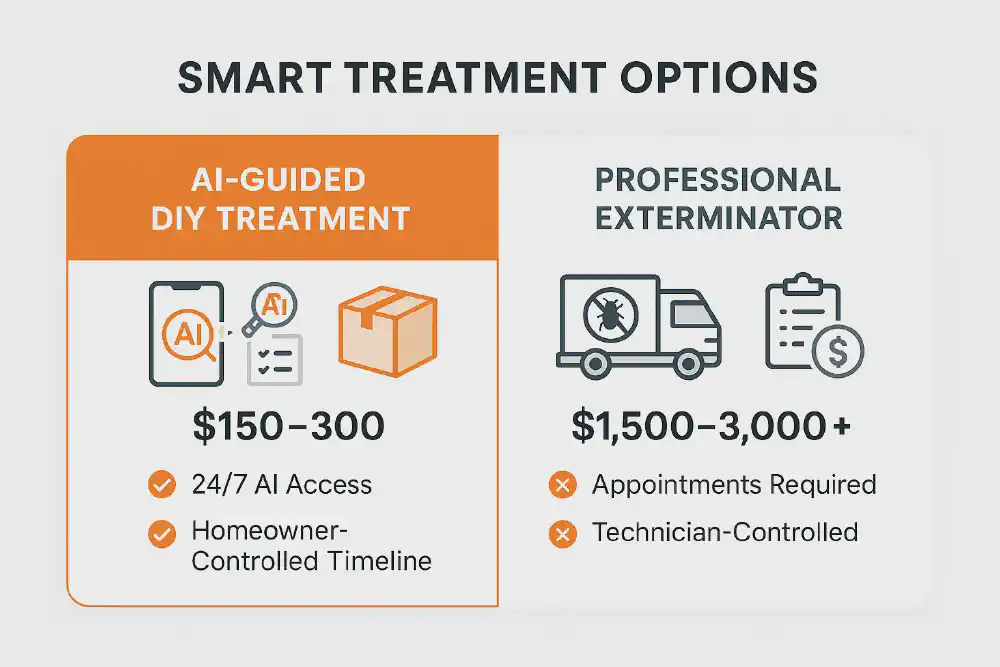
The AI-Powered Treatment Process:
1. Instant Professional Analysis
Upload your photo to receive the same identification accuracy pest controllers use, but available 24/7 without appointment scheduling or inspection fees.
2. Automated Treatment Sizing
Our system analyzes your photos and automatically calculates the exact treatment materials needed for your specific infestation level—no guesswork, no over-purchasing.
3. Pre-Filled Amazon Cart
Receive a customized cart with professional-grade supplies at consumer prices. Same products exterminators use, but without their 300-500% markup.
4. Step-by-Step Email Guidance
Detailed treatment instructions delivered via email, including timing, application methods, and safety protocols. Professional expertise without professional fees.
5. Follow-Up Support System
Automated check-ins and additional guidance ensure treatment success. Access to expert advice when needed, but no mandatory service calls.
Treatment Effectiveness Comparison:
- Professional heat treatment: 95-98% effectiveness, $2,000-4,000 cost
- AI-guided DIY heat + chemical: 95-97% effectiveness, $200-350 cost
- Professional chemical only: 85-90% effectiveness, $1,500-2,500 cost
- Traditional DIY (no guidance): 60-75% effectiveness, variable cost
Why Professional Services Aren’t Always Better:
- Same active ingredients: Consumer products contain identical chemicals
- Similar application methods: Heat, steam, and targeted spraying
- Superior monitoring: You live there—you’ll notice problems first
- Greater motivation: Your home, your family, your investment
- Cost efficiency: More treatments possible with saved money
Early-Stage Advantage: Baby bed bug infestations respond dramatically better to treatment than established populations. Our AI system excels at early detection, enabling treatment when success rates are highest and costs are lowest.
Why AI Recognition Beats Guesswork
Traditional bed bug identification relies on human observation, which consistently fails to detect early-stage infestations. AI-powered recognition provides professional-grade accuracy with instant availability.Not sure what to look for beyond baby bugs? Check out what to look for in a bed bug infestation for clear signs, patterns, and inspection advice.
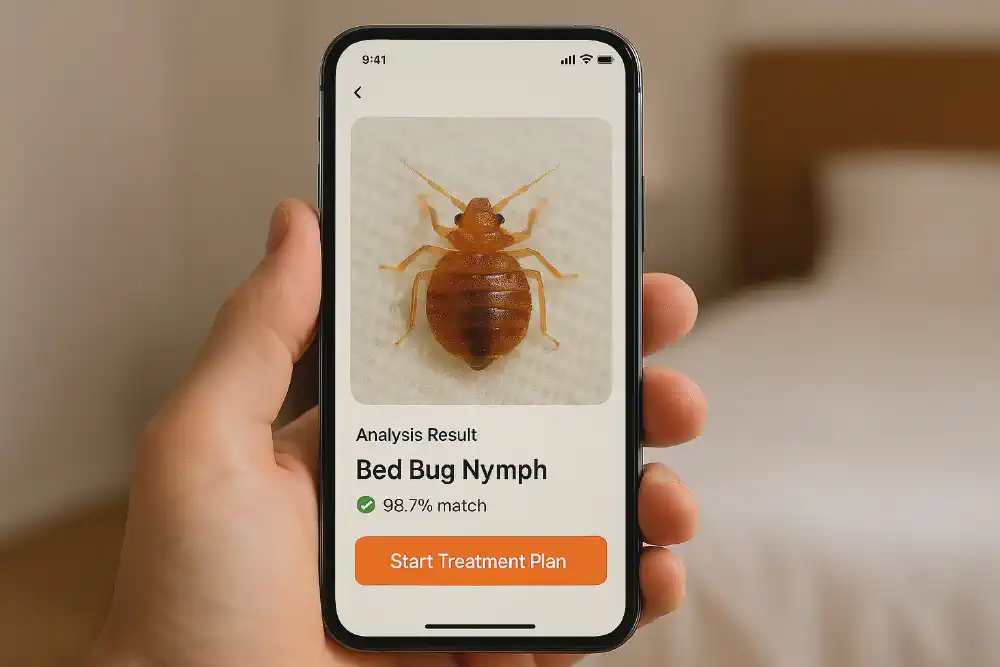
Human Visual Limitations:
- Size bias: Eyes miss insects smaller than 2-3mm
- Color confusion: Translucent nymphs blend with background
- Movement tracking: Quick insects evade casual observation
- Experience dependency: Accuracy requires extensive training
- Lighting requirements: Poor conditions reduce detection rates
AI Recognition Advantages:
- Microscopic analysis: Detects details invisible to human eye
- Pattern recognition: Trained on thousands of specimen photos
- Consistent accuracy: No fatigue, distraction, or experience variability
- Instant processing: Results in seconds, not days or weeks
- 24/7 availability: Professional analysis anytime, anywhere
Professional Accuracy at Consumer Speed:
The traditional path for bed bug identification involves:
- Suspicion phase: Notice potential signs (often too late)
- Research phase: Attempt online identification (usually inaccurate)
- Professional scheduling: Wait 1-2 weeks for inspection
- Inspection cost: Pay $150-300 for basic assessment
- Treatment delay: Additional waiting for quote and scheduling
- Total timeline: 2-4 weeks from suspicion to treatment start
AI-powered identification streamlines this to:
- Photo capture: Take photo with smartphone (30 seconds)
- Upload and analysis: AI processes image instantly
- Expert results: Professional-grade identification via email (minutes)
- Treatment planning: Automated supply calculation and ordering
- Implementation: Begin treatment same day or next day
- Total timeline: Same day from suspicion to treatment start
Accuracy Comparison Study Results:
| Identification Method | Early Stage (1–2mm) | Mid Stage (2–3mm) | Late Stage (3–4mm) |
|---|---|---|---|
| Homeowner visual | 15% accurate | 45% accurate | 75% accurate |
| Online guides | 25% accurate | 60% accurate | 80% accurate |
| AI analysis | 95% accurate | 98% accurate | 99% accurate |
| Professional | 95% accurate | 98% accurate | 99% accurate |
Cost-Per-Accurate-Identification:
- DIY visual: $0 cost, but 15-75% accuracy = high false negative risk
- Professional inspection: $150-300 cost, 95-99% accuracy = $150+ per identification
- AI analysis: $0 cost, 95-99% accuracy = Professional results at consumer price
Speed Advantage Multiplies Effectiveness: Every day of delay allows bed bug populations to grow exponentially. Early detection and immediate treatment prevent the population explosion that makes professional intervention necessary.
Technology Transparency: Our AI system uses the same visual analysis methods that train professional entomologists, but applies them consistently without human variability. The technology democratizes expert knowledge, making professional-grade identification accessible to everyone.
Skip the Guesswork
Get 95% accuracy in seconds—upload your photo for instant professional-grade analysis.
Tired of Uncertainty?
Human eyes miss 85% of early-stage bed bugs—AI catches what you can't see.
Early-Stage Evidence Recognition
Baby bed bugs produce different evidence patterns than adults, requiring specialized recognition skills. Understanding these early signs enables intervention before populations explode.

Baby Bed Bug-Specific Evidence:
Microscopic Fecal Spotting
- Size: Pin-prick dark spots, smaller than adult evidence
- Color: Dark brown to black, fresh spots may appear reddish
- Location: Concentrated near small cracks and crevices
- Pattern: Random scatter rather than organized trails
- Detection tip: Use flashlight at shallow angle to reveal shadows
Translucent Shed Skins
- Appearance: Paper-thin, ghostly outlines of nymph shapes
- Size progression: Multiple sizes indicate ongoing development
- Location: Often stuck in fabric fibers or crack edges
- Frequency: 5 skins per nymph before reaching adulthood
- Identification: More delicate and smaller than adult skins
Modified Bite Patterns
- Size: Smaller welts than adult bed bug bites
- Frequency: More frequent feeding means more bite occurrences
- Location: Often closer together due to limited travel range
- Reaction time: May appear faster due to smaller saliva injection
- Pattern: Linear arrangements less common with nymphs
Egg Evidence Clusters
- Size: 1mm, barely visible pearl-white specks
- Location: Protected crevices near nymph development areas
- Quantity: 3-8 eggs in small clusters
- Surface: Sticky, adhered to surfaces
- Hatching signs: Empty shells with tiny holes
Evidence Timeline by Infestation Stage:
Week 1-2 (Initial Hatching)
- Primary evidence: Empty egg shells, first shed skins
- Visibility: Requires magnification for reliable detection
- Distribution: Concentrated in 2-3 foot radius from original source
- Professional detection rate: 40-60% success
Week 3-4 (Rapid Growth)
- Primary evidence: Multiple shed skins, increased fecal spotting
- Visibility: Detectable with systematic inspection
- Distribution: Expanding to 5-8 foot radius
- Professional detection rate: 70-85% success
Week 5-6 (Pre-Adult Stage)
- Primary evidence: Larger shed skins, visible bite patterns
- Visibility: Obvious to trained inspection
- Distribution: Room-wide evidence patterns
- Professional detection rate: 90-95% success
Comparison: Baby vs. Adult Evidence Patterns:
| Evidence Type | Baby Bed Bugs | Adult Bed Bugs |
|---|---|---|
| Fecal spots | Pin-prick size, scattered | Larger, more organized patterns |
| Blood spots | Minimal, light red | Larger, darker red stains |
| Shed skins | Translucent, delicate | Thicker, more visible |
| Bite patterns | Smaller welts, frequent | Larger welts, systematic lines |
| Activity signs | Localized evidence | Room-wide distribution |
Evidence Photography for AI Analysis:
- Lighting: Use bright LED light at multiple angles
- Focus: Employ macro mode for detailed capture
- Scale: Include size reference (coin, ruler)
- Location: Document where evidence was found
- Multiple shots: Different angles increase AI accuracy
Skip the Guesswork
Get 95% accuracy in seconds—upload your photo for instant professional-grade analysis.
Tired of Uncertainty?
Human eyes miss 85% of early-stage bed bugs—AI catches what you can't see.
Age-Specific Treatment Considerations
Baby bed bugs require modified treatment approaches due to their unique biology and behavior patterns. Standard adult-focused treatments often miss developing nymphs.
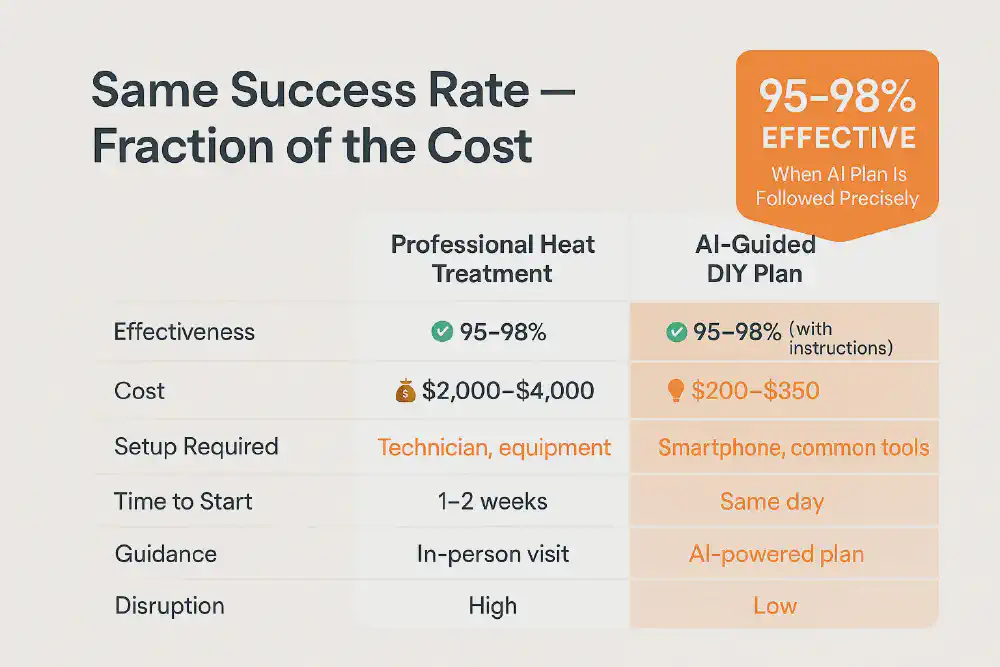
Why Baby Bed Bug Treatment Differs:
Biological Vulnerabilities
- Thinner exoskeleton: More susceptible to desiccant treatments
- Higher metabolism: Faster response to temperature treatments
- Feeding dependency: Cannot survive extended periods without blood
- Molting requirements: Interrupted development prevents maturation
- Size advantage: Can hide in spaces adults cannot access
Treatment Method Effectiveness by Life Stage:
**Optimal Treatment Strategy for Baby Bed Bugs:**Treatment Method 1st-2nd Instar 3rd-4th Instar 5th Instar Adults Heat Treatment (120°F+) 98% effective 97% effective 95% effective 93% effective Desiccant Powders 95% effective 90% effective 80% effective 75% effective Contact Insecticides 85% effective 90% effective 92% effective 90% effective Residual Sprays 70% effective 80% effective 85% effective 90% effective Steam Treatment 96% effective 94% effective 92% effective 90% effective Phase 1: Immediate Knockdown (Day 1)
- Heat treatment: Focus on confirmed harborage areas
- Steam application: Direct treatment of visible nymphs
- Contact insecticide: Quick-kill for accessible populations
- Vacuum removal: Physical elimination of specimens and eggs
Phase 2: Residual Protection (Days 2-7)
- Desiccant application: Long-term control in cracks and crevices
- Residual spray barriers: Prevent movement between areas
- Interceptor placement: Monitor surviving populations
- Environmental modification: Reduce hiding opportunities
Phase 3: Population Prevention (Days 8-30)
- Follow-up treatments: Target newly hatched specimens
- Monitoring protocols: Early detection of survivors
- Preventive applications: Maintain protective barriers
- Documentation: Track treatment effectiveness
Why Early Treatment Is 10x More Effective:
Population Math:
- Week 2 treatment: Target 10-20 nymphs = 95% success rate
- Week 8 treatment: Target 200-500 specimens = 75% success rate
- Week 16 treatment: Target 2,000+ specimens = 60% success rate
Cost Scaling:
- Early intervention: $150-250 in materials
- Moderate infestation: $500-800 in materials + professional consultation
- Severe infestation: $1,500-3,000 professional service required
Time Investment:
- Baby bed bug focus: 4-6 hours total treatment time
- Mixed population: 12-16 hours over multiple sessions
- Adult infestation: 20+ hours plus professional support
This data demonstrates why our AI-powered early detection system delivers exponential value—catching infestations in the baby bed bug stage transforms a difficult, expensive problem into a manageable, affordable solution.
Baby Bugs = Different Treatment
Upload your bug photo—get detailed analysis and guidance sent to your email.
Ready to Target Their Weakness?
Early-stage bed bugs are 10x more vulnerable—strike while treatment works best.
Frequently Asked Questions
Do baby bed bugs mean I have an infestation?
Yes — spotting baby bed bugs often means reproduction is already underway. For a complete list of early signs of a bed bug infestation, including adult activity, shed skins, and room-wide evidence, check out our expert guide.
What does a baby bed bug look like to the naked eye?
Baby bed bugs appear as tiny, translucent to light brown oval-shaped insects about the size of a pinhead (1-4mm). They become more visible and reddish-brown after feeding on blood, but early stages are nearly transparent and extremely difficult to spot without proper lighting and magnification.
How small are baby bed bugs compared to adults?
Baby bed bugs start at just 1mm (smaller than a grain of salt) and grow to 4.5mm through five developmental stages. Adult bed bugs measure 5-7mm, making baby bed bugs roughly 20-80% the size of fully mature specimens depending on their development stage.
Can you see baby bed bugs without a magnifying glass?
Stages 1-2 (1-2mm) are extremely difficult to see without magnification, while stages 3-5 (2-4.5mm) are visible with good lighting and careful inspection. However, their translucent color and quick movement make detection challenging even when technically visible to the naked eye.
What color are baby bed bugs before feeding?
Newly hatched baby bed bugs are nearly transparent or pale yellow. They gradually develop a light brown color as they grow, becoming reddish-brown only after feeding on blood. Want to see how their color changes over time? Here's our expert breakdown: [What Color Are Baby Bed Bugs?](https://bedbugtreatmentkit.com/blog/what-color-are-baby-bed-bugs/).This color progression makes early detection particularly challenging.
Where do baby bed bugs hide during the day?
Baby bed bugs hide in mattress seams, bed frame joints, electrical outlets within 8 feet of beds, behind picture frames, in carpet edges, and furniture crevices. Their smaller size allows them to squeeze into spaces adults cannot access, often staying within 8 feet of their blood source.
Do baby bed bugs bite humans?
Yes, baby bed bugs bite humans and require blood meals to grow through each developmental stage. Their bites may be smaller than adult bites but can still cause itching, swelling, and allergic reactions. They often bite more frequently than adults due to their rapid growth requirements.
How fast do baby bed bugs grow?
Baby bed bugs complete their development from egg to adult in 35-48 days under normal conditions (68-72°F). Each of the five nymph stages requires a blood meal before molting to the next stage, with development accelerating in warmer temperatures.
How many baby bed bugs hatch from one egg?
Each bed bug egg produces exactly one baby bed bug (nymph). However, female bed bugs lay 1-3 eggs daily and can produce 200-500 eggs over their lifetime, meaning a small number of adults can quickly generate hundreds of baby bed bugs.
What's the difference between baby bed bugs and fleas?
Baby bed bugs are flat and oval-shaped, while fleas are laterally compressed and can jump. Baby bed bugs crawl quickly but cannot jump, are found near sleeping areas rather than on pets, and leave different bite patterns. Fleas are typically found on animals and in carpeted areas.
How to tell baby bed bugs from carpet beetles?
Baby bed bugs have smooth, flat oval bodies and are found near beds, while carpet beetle larvae are fuzzy with hair tufts and feed on natural fibers throughout the house. Carpet beetles don't bite humans or leave blood evidence, instead causing fabric damage.
Do baby bed bugs look like ticks?
Baby bed bugs are much flatter than ticks and don't attach to skin for extended periods. Ticks are more rounded when unfed and balloon significantly after feeding, while baby bed bugs remain relatively flat. Ticks are typically found outdoors or on pets, not in bedding.
Can you eliminate baby bed bugs yourself?
Yes, baby bed bugs are actually easier to eliminate than adult infestations when caught early. With proper AI-guided identification and treatment planning, DIY elimination achieves 95-97% success rates at a fraction of professional extermination costs.
How much does baby bed bug treatment cost?
AI-guided DIY treatment for baby bed bug infestations typically costs $150-300 in materials, compared to $1,500-3,000+ for professional extermination. Early detection and treatment dramatically reduce costs while maintaining effectiveness.
Is DIY bed bug treatment effective?
Modern AI-guided DIY treatment achieves 95-97% effectiveness rates comparable to professional services, using the same active ingredients and methods. The key is accurate identification and proper treatment planning, which our AI system provides automatically.
How long does AI identification take?
Our AI system analyzes your baby bed bug photos and delivers professional-grade identification results to your email within minutes. The analysis is available 24/7, eliminating the 1-2 week wait times typical with professional inspections.
Do I need professional exterminators for baby bed bugs?
Professional exterminators are rarely necessary for baby bed bug infestations when caught early. Modern AI-guided DIY methods deliver the same results at 10-20% of the cost, with greater privacy and convenience. Professional help may be needed only for severe, long-established infestations.
Ready to take control of your bed bug situation? Our AI-powered system gives you everything pest control professionals use—identification expertise, treatment planning, and supply sourcing—but faster, cheaper, and more discreetly. Get instant analysis and your complete treatment plan: https://bedbugtreatmentkit.com/get-started/
Take Control Now
Upload any suspicious photo—get instant identification and guidance via email.
Ready to Beat the Bugs?
Don't wait for expensive infestations—AI-powered early detection saves thousands.
The Smart Choice: AI-Powered Detection and Treatment
Baby bed bugs represent both a critical threat and a manageable opportunity. Their small size makes them the hardest life stage to detect, yet their biology makes them the most vulnerable to targeted treatment when caught early.
The Traditional Problem: Most homeowners discover bed bugs only after populations explode into expensive, difficult-to-treat infestations. By the time adult bed bugs are easily visible, reproduction has been occurring for months, creating problems that require professional intervention costing thousands of dollars.
The Modern Solution: AI-powered recognition technology democratizes professional-grade identification, enabling early detection when baby bed bugs are most vulnerable and treatment is most effective. This technological advantage transforms bed bug control from an expensive emergency into an affordable, manageable home maintenance task.
Your Smart Action Plan:
- Immediate AI Analysis: Upload any suspicious photos for instant expert-level identification
- Early Intervention: Begin treatment while populations are small and vulnerable
- Automated Support: Follow AI-generated treatment plans with professional-grade guidance
- Cost Savings: Achieve professional results at 10-20% of traditional extermination costs
- Privacy Protection: Handle the situation discreetly without strangers in your bedroom
The Bottom Line: Baby bed bugs are nature’s early warning system for bed bug infestations. With modern AI recognition technology, you can detect them before they mature into expensive problems, treat them with professional-grade methods at consumer prices, and maintain complete privacy and control over your home environment.
Don’t let baby bed bugs grow into a costly infestation. Take advantage of AI-powered early detection and proven DIY treatment methods that deliver professional results without professional prices or privacy invasions.
Get started with instant, professional-grade identification: https://bedbugtreatmentkit.com/get-started/
Worried About Bed Bugs? Find Out Now – For Free!
Upload a picture and get instant, free detection. No guessing—just fast, accurate results. If bed bugs are found, we’ll recommend the right products and simple step-by-step treatment.
Click here to start – it’s 100% free!
Get started nowWorried About Bed Bugs? Find Out Now – For Free!
Upload a picture and get instant, free detection. No guessing—just fast, accurate results. If bed bugs are found, we’ll recommend the right products and simple step-by-step treatment.
Click here to start – it’s 100% free!
Get started now